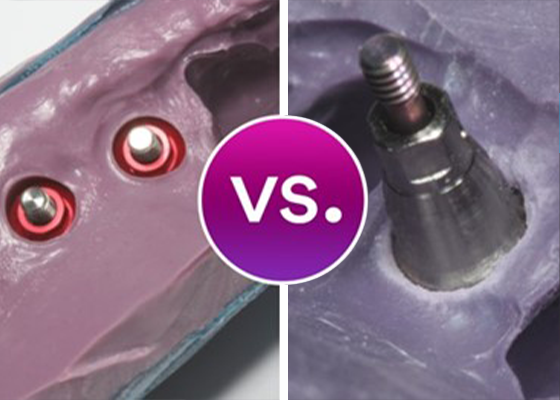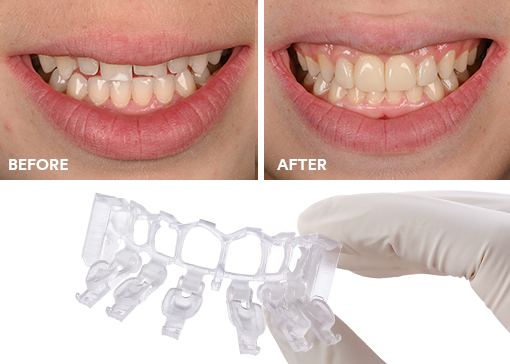Zirconia puzzle: what makes zirconia unique and how to choose the right zirconia
Zirconia may be part of your everyday vocabulary, but how much do you know about this ceramic material? Learn more…


The accuracy of your next implant impression starts with selecting the right material – and the right technique. Take a closer look at your options, and what your choices mean for your procedure, your efficiency, and ultimately, the quality of your results.
If you are like me and you want to ensure accuracy, simplicity and efficiency in your impression procedures, then three things play a decisive role in making an accurate implant impression: knowing which technique to use and when; why you chose that technique; and selecting the right material.
There are primarily two impression techniques – open and closed, based on the type of impression copings: open tray (direct pick-up) or closed tray (indirect transfer). A less common approach is the “snap-on” technique (closed tray, direct transfer), which is a hybrid of the other two and is not discussed here.

In this technique, the impression coping remains on the implant during impression making and removal of the set impression from the mouth (similar to conventional crown and bridge procedures). The coping is removed from the implant and then attached to the implant analogue. The coping/analogue assembly is then seated (transferred) back into its corresponding indexed position inside the impression.

Closed Tray Indirect Transfer1
In this technique, the impression coping is ‘picked-up’ and remains in the set impression upon removal from the mouth. Once the impression has set, the screw holding the coping on the implant is accessed through a hole in the tray and unscrewed to allow removal of the impression from the mouth. Once outside of the mouth, the implant analogue is connected to the coping.

Open Tray Direct Pick-up1
These techniques are interchangeable and utilized depending on the clinical situation. However, the open tray technique usually comes with added anxiety, time and cost since you have to ensure you can find and access the coping screw in order to remove the impression. If you have ever locked an impression, you know exactly what I mean… It happened to me once, and I’ll never make that mistake again!
Single unit restorations
The literature points to the open tray technique being more accurate.1,2 In my opinion, there is little difference between closed and open tray impressions when it comes to single-unit restorations as long as you use the right material.
What do I use? I routinely use the closed tray simply because of its ease of use. This becomes a predictable technique, especially when used in combination with a super rigid, simple to use material such as polyether from the 3M™ Impregum™ Impression Material family. Using such a material gives me confidence: its high rigidity secures the implant coping position and using a single material consistency in a monophase technique keeps the procedure simple.
A monophase polyether is very versatile in its use. These photos show the same material being used as a tray material and for syringing abutments. The material in the syringe exhibits what we call shear thinning, making it behave like a light body wash. In this state, you can focus on the simple task of syringing around the coping only – that’s it!

Multiple implants1
Having taken hundreds of impressions with a 100% successful fit, the closed tray technique with 3M™ Impregum™ Penta™ Impression Material used in a monophase technique is a very reliable combination. In my experience, this technique helps to standardize the procedure, to simplify and help you reduce the variability of the outcome, errors and cost.
Multiple implants
If you have multiple implants that will be splinted, an open tray technique will be more accurate and should be used. A classic polyether with a longer working time will allow you more freedom in ensuring the correct seating position of the tray. Impregum Penta Impression Material has a unique snap-set behavior meaning that the material continues flowing during the entire working time. This makes the material forgiving – the extra flowability allows you to carefully maneuver the tray in order to find the hole without compromising impression accuracy.
Remember, if the implants are misaligned, it is advisable to use an open tray impression coping. Using a closed tray technique for misaligned copings would risk locking the impression in the mouth because of their lack of draw. In general, if in doubt about which to use for accuracy, then use an open tray impression coping – you won’t go wrong – it is the gold standard.
Regardless of technique, always check for accurate positioning of the impression coping before hand-tightening and proceeding with the next step. The table below helps to summarize the advantages, disadvantages and clinical use for each technique, plus my material recommendations:

What I expect from an impression material is easily summed up: it should be universal (i.e. suited for the ‘open’ tray and ‘closed’ tray impression technique alike), and it should enable me to capture the complete three-dimensional position of the restorative implant platform, including the teeth and soft tissues. With those criteria met, you are only left to select the appropriate working time.
Selecting the right technique for the right clinical situation will help you to achieve the detailed impression on the first take. Remember to look at the clinical presentation and have your end goal in mind – this will allow you to systematically work through your chosen technique from start to finish. Why not simplify and choose a monophase material that does it all: that securely captures impression posts, streamlines the procedure, gives ultimate accuracy and helps you to overcome any challenges.

Zirconia may be part of your everyday vocabulary, but how much do you know about this ceramic material? Learn more…

Achieving the correct shape is vital to a natural-looking anterior composite restoration. Learn how the 3M™ Filtek™ Matrix, paired with…

Direct composite restorative procedures can be challenging, particularly when it comes to esthetic cases. Discover how new techniques and tools…